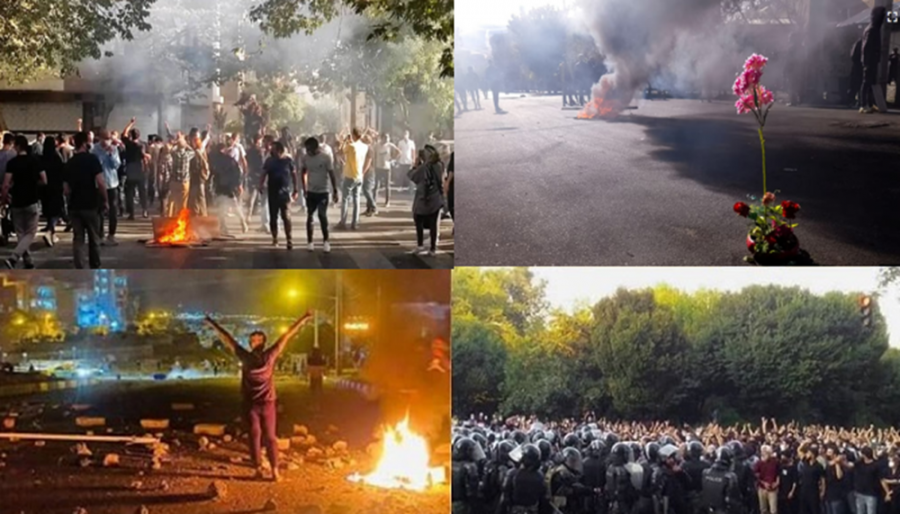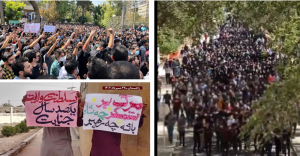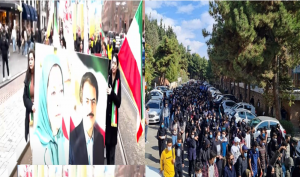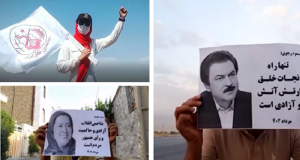
(Video) How PMOI Resistance Units are shaping Iran’s democratic future
The PMOI Resistance Units were born, emerging as a network of small, nimble groups of activists ready to challenge the regime’s authority at every turn.
PARIS, FRANCE, August 14, 2024 /EINPresswire.com/ -- The official website of the People’s Mojahedin Organization of Iran (PMOI/MEK) in an article published that Iran stands at a pivotal moment in its history, poised on the brink of profound transformation.
The long-cherished dream of fundamental change has never seemed more attainable. Between December 2017 and January 2022, six nationwide uprisings swept across the country, illuminating the Iranian people’s burning desire to overthrow the clerical regime and establish a democratic republic in its place.
These protests were remarkable not only for their scale and frequency but also for the boldness of their message. In cities and towns across Iran, thousands of demonstrators voiced their discontent through powerful slogans that cut to the heart of the nation’s political future.
Chants of “No to Shah, No to mullahs” reverberated through the streets, rejecting both the monarchy of the past and the current theocratic rule. The cry “Down with the mullahs’ rule” directly challenged the foundational concept of the Iranian regime. Most daringly, protesters called for “Death to Khamenei,” targeting the regime’s Supreme Leader himself.
The depth of frustration and determination was palpable in declarations like “For 40 years we shed bloodied tears, enough is enough, we’ll take a stand.” These impassioned words encapsulate decades of struggle against oppression and a renewed resolve to forge a different path forward.
These slogans are more than mere rhetoric; they represent the Iranian people’s profound yearning for freedom and democracy. This desire has persisted and grown despite 45 years of brutal repression, including widespread torture and executions aimed at crushing dissent. The tenacity of the Iranian spirit in the face of such sustained adversity is truly remarkable.
However, past protests and experience have shown that the regime will not fall through people’s protests alone, but requires an organized resistance leading these demonstrations.
A critical question now faces Iran and those observing its struggle: Which force, strategy, and course of action can successfully topple the current regime and guide Iran toward a democratic future?
In the past six years, a new phenomenon has emerged that has significantly impacted protests across the country. The “PMOI Resistance Units,” a network of activists supporting the Iranian opposition movement, the People’s Mojahedin Organization of Iran (PMOI/MEK), have played an increasingly visible role.
These units represent an organized and motivated force within the broader landscape of Iranian dissent, potentially offering a structured approach to challenging the regime’s authority.
The Birth of a Movement
The concept of Resistance Units is deeply rooted in the Iranian Resistance’s long-held belief that genuine change in Iran must come from within, driven by the Iranian people themselves. This grassroots approach has proven remarkably effective in mobilizing dissent and organizing protests despite the regime’s relentless efforts to crush any form of opposition.
The idea gained significant traction in 2017 when Iran witnessed its first major nationwide uprising in years. As protests spread across the country, it became clear that a more organized and structured form of resistance was necessary to sustain the momentum and channel the people’s anger into effective action.
Thus, the PMOI Resistance Units were born, emerging as a network of small, nimble groups of activists ready to challenge the regime’s authority at every turn.
Who Are the Resistance Units?
The Resistance Units are composed of small cells of Iranian activists who have taken a bold stand against the current regime. Led and organized by the PMOI’s extensive network inside Iran, these groups of determined individuals operate in cities and towns across the country, from the bustling streets of Tehran to the remote regions of Baluchestan, from the oil-rich province of Khuzestan to the mountainous terrain of Azerbaijan.
What sets the Resistance Units apart is their diversity and broad reach. Their ranks include Iranians from all walks of life – students, workers, professionals, and even former regime insiders who have become disillusioned with the system.
They come from different ethnic backgrounds, representing Iran’s rich cultural tapestry. What unites them is a shared vision: the overthrow of the theocratic dictatorship and the establishment of a democratic, secular republic that respects human rights and individual freedoms.
The Resistance Units operate under extremely dangerous conditions. The Iranian regime, known for its brutal suppression of dissent, has made targeting these activists a top priority.
Members of the Resistance Units face the constant threat of arrest, torture, and execution. Yet, despite these risks, their numbers continue to grow, a testament to the Iranian people’s yearning for change and their willingness to sacrifice for freedom.
The Resistance Units: Activities and Impact on Iran’s Protest Movement
The Resistance Units play a crucial role in Iran’s ongoing struggle for democracy and freedom. These groups engage in a wide range of activities aimed at undermining the regime’s authority and inspiring hope among the Iranian people. Their actions are diverse, creative, and often daring, designed to keep the flame of resistance burning bright even in the darkest times.
Key activities of the Resistance Units include:
1. Organizing and Leading Protests: The Units coordinate demonstrations, plan routes, communicate gathering points, and work to ensure protesters’ safety. They provide tactical guidance and help maintain the momentum of protests.
2. Spreading Messages of Resistance: Through leaflets, banners, and street activities, they promote slogans of freedom and democracy, breaking the atmosphere of fear imposed by the regime.
3. Commemorating Martyrs: They honor those who have sacrificed their lives for Iran’s freedom through ceremonies, memorial posters, and social media campaigns.
4. Targeting Regime Symbols: During protests and separate operations, they focus on destroying images and statues of regime leaders, demystifying the regime’s supposed invincibility.
5. Amplifying Opposition Voices: They spread messages from Iranian Resistance leaders, particularly Maryam Rajavi’s 10-point plan for a democratic and secular Iran.
6. Documenting and Reporting: In a country with restricted independent journalism, they capture and share footage of demonstrations, human rights violations, and daily life under the regime.
The impact of the Resistance Units has been particularly evident in shaping Iran’s protest movement since 2017. They have played a pivotal role in sparking and sustaining protests, maintaining a state of continuous unrest that can quickly escalate into larger demonstrations. Their consistent promotion of slogans like “No to Shah, No to mullahs” has helped shape the discourse of the protest movement.
One of their most significant achievements has been breaking the barrier of fear that the regime has long relied upon. By consistently challenging the regime despite severe risks, they inspire others to join the struggle.
Their diverse composition allows them to connect with various segments of Iranian society, bridging divides between different social, ethnic, and economic groups.
In the face of brutal repression, the Resistance Units have not only persevered but grown stronger. During the 2022 protests, over 3,600 members were arrested or disappeared. However, their ranks continue to grow, demonstrating their resilience and the widespread support for their cause.
The widespread activities of the Resistance Units and their dedication to a democratic future for Iran were powerfully demonstrated during the Free Iran 2024 Summit, where they sent more than 20,000 messages supporting the Iranian Resistance and endorsing Maryam Rajavi’s Ten-Point Plan.
Through their activities, the Resistance Units have also played a crucial role in internationalizing the struggle. Their documentation and reporting provide invaluable evidence of the regime’s human rights abuses and the Iranian people’s desire for change, helping to garner international support for the cause of Iranian freedom.
In essence, the Resistance Units serve as the backbone of Iran’s pro-democracy movement, continuously challenging the regime’s authority, inspiring hope among the populace, and working tirelessly towards the goal of a free and democratic Iran.
The Iranian Regime’s Growing Fear of PMOI Resistance Units: A Testament to Their Impact
The Iranian regime’s escalating concern over the PMOI Resistance Units has become increasingly evident through official statements and state media coverage. This mounting apprehension speaks volumes about the critical role these units play in sparking and guiding uprisings against the regime, potentially paving the way for its eventual overthrow.
The regime’s Supreme Leader Ali Khamenei’s repeated warnings about the PMOI’s influence underscore the regime’s recognition of the threat posed by these organized resistance efforts. In January 2018, Khamenei explicitly identified the PMOI as a key force behind nationwide protests, stating they were “the third side of a triangle that created the uprising that they had prepared months earlier.”
The regime’s anxiety is not limited to top leadership. State-run media outlets have also acknowledged the PMOI’s growing impact. In August 2018, the publication Baharestaneh noted the PMOI’s “infiltration” across various social classes, from truckers to teachers, highlighting the broad appeal of the resistance movement.
The article warned of the Resistance Units’ ability to “multiply and replace the leaders of the scene,” indicating the regime’s fear of losing control of this organized opposition.
The 2022 nationwide uprising further solidified the regime’s perception of the PMOI as an existential threat. Despite the arrest or disappearance of over 3,600 Resistance Unit members, their influence continued to grow. This resilience in the face of severe repression demonstrates the deep-rooted support for the PMOI within Iranian society.
Recent admissions from regime-affiliated “experts” during a roundtable discussion organized by the state news agency IRNA reveal the depth of the regime’s concern. Participants acknowledged that the PMOI’s enduring influence stems not from foreign support, but from its resonance with the Iranian people, particularly the youth. This recognition of the PMOI’s domestic support base is a stark admission of the regime’s failing grip on power.
Importantly, the regime’s fear is not merely rhetorical. It has manifested in concrete actions that reveal the depth of their concern. A prime example is the recent sham trial in absentia of 104 PMOI members. This theatrical performance, far from being a legitimate legal proceeding, is a clear expression of the regime’s fear and desperation.
On May 28, 2024, during this mock trial, the presiding judge made a telling statement: “We warn the countries hosting the accused that hosting these defendants is considered a crime under international conventions against terrorism!”
The judge then continued with a threatening tone toward countries hosting PMOI members, calling for their extradition. This attempt to intimidate other nations into complying with the regime’s wishes underscores the perceived threat the PMOI poses to the Iranian regime’s stability.
The regime’s reaction to the Resistance Units goes beyond mere rhetoric and show trials. The implementation of harsh measures, including mass arrests, torture, and executions, reflects a desperate attempt to quell a movement that threatens the very foundations of clerical rule. However, these brutal tactics have only served to strengthen the resolve of the Resistance Units and their supporters.
The PMOI’s ability to unite various segments of Iranian society under a common cause of freedom and democracy has rattled the regime. As one regime expert conceded, “Our main issue in the country is the PMOI, and we must address it.” This statement encapsulates the central challenge the Resistance Units pose to the continuation of theocratic rule in Iran.
For years, the Iranian regime has propagated a narrative that the PMOI lacks popular support within the country. This claim, often echoed by regime sympathizers and some Western policymakers, has been used to justify continued engagement with the current theocratic regime.
However, a closer examination of the activities of PMOI Resistance Units and the regime’s actions reveals a starkly different reality one that exposes the depth of the regime’s fear and the true extent of the PMOI’s influence.
The expansion of PMOI Resistance Units across Iran tells a compelling story that contradicts the regime’s narrative. Perhaps the most telling indicator of the PMOI’s popular support is the Iranian regime’s response to their activities.
The sheer scale and intensity of the regime’s propaganda campaign against the PMOI speak volumes about the perceived threat. Within Iran, the regime has produced an astounding volume of anti-PMOI material, including nearly a thousand book titles, hundreds of hours of films and television series, and numerous “exhibitions” in cities, universities, and mosques across the country.
This domestic propaganda machine is complemented by a sophisticated international disinformation network. The regime has invested millions of dollars in placing anti-PMOI articles in Western media outlets and has cultivated a cadre of “friendly journalists” to propagate its narrative globally.
The recent exposure of the “Iran Experts Initiative” revealed a coordinated effort to strategically place regime agents within Western think tanks, advisory groups, and media organizations.
The question that naturally arises is: Why would the Iranian regime invest such enormous resources in demonizing a group that it claims lacks popular support? The answer lies in the regime’s existential fear of the PMOI and the National Council of Resistance of Iran (NCRI), of which the PMOI is a main constituent.
The regime’s extensive efforts to demonize and suppress the PMOI reveal its recognition of the PMOI, the main constituent of the NCRI as a viable alternative and a significant threat to its continued rule.
The Future of Iran’s Resistance Movement: A Catalyst for Change in a Powder Keg Society
As Iran teeters on the brink of widespread social upheaval, the role of the PMOI Resistance Units has become increasingly pivotal. The Iranian society, aptly described as a powder keg ready to explode at any moment, finds itself with a powerful catalyst in the form of these organized resistance cells spread across the nation.
The strategic positioning of PMOI Resistance Units throughout Iran’s diverse social fabric provides a unique advantage. These units serve as the connective tissue that can rapidly transform localized protests into national uprisings. Their presence in various sectors of society from urban centers to rural areas, within universities, factories, and neighborhoods – allows for swift communication and coordination of protest actions.
This widespread network presents a significant challenge to the regime’s suppressive forces, including the IRGC. Unlike spontaneous protests that can be easily quelled, the Resistance Units provide structure and continuity to opposition movements. Their ability to sustain prolonged campaigns of protest severely hampers the regime’s capacity to restore order through brute force alone.
The decentralized nature of the Resistance Units makes them particularly resilient to suppression efforts. As these units are dispersed across the country and deeply embedded within different social strata, the regime faces an uphill battle in attempting to neutralize their influence.
Traditional methods of cracking down on opposition – such as targeting specific leaders or organizations prove ineffective against this grassroots network.
Looking to the future, the role of the Resistance Units is likely to become even more crucial. The path to a free and democratic Iran is undoubtedly challenging and fraught with risks and potential setbacks.
However, the presence of a well-organized, deeply-rooted resistance movement provides a clear roadmap for change. The PMOI Resistance Units, with their widespread presence and unwavering commitment to democratic values, stand ready to guide Iran through this transformative period.
If you wish to receive the NCRI weekly Newsletter, please use the following link to subscribe: https://bit.ly/3SMgEla.
Shahin Gobadi
NCRI
+33 6 61 65 32 31
email us here
The Resistance units represent an organized and motivated force within the broader landscape of Challenging the regime for freedom.
Distribution channels: Human Rights, International Organizations, Politics, U.S. Politics, World & Regional
Legal Disclaimer:
EIN Presswire provides this news content "as is" without warranty of any kind. We do not accept any responsibility or liability for the accuracy, content, images, videos, licenses, completeness, legality, or reliability of the information contained in this article. If you have any complaints or copyright issues related to this article, kindly contact the author above.
Submit your press release




